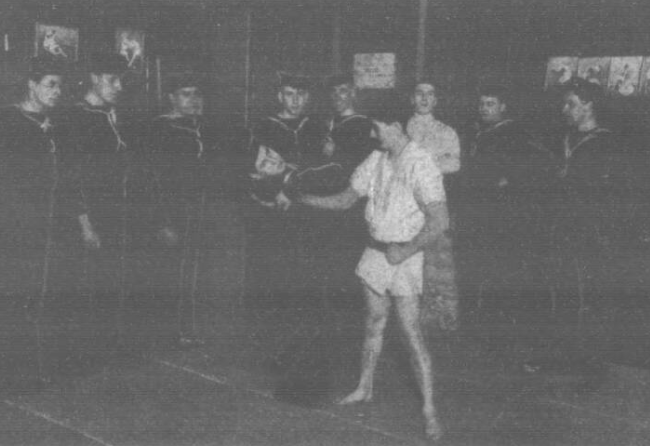- Originally published on the Bartitsu.org site on Wednesday, 28th December 2016

Suddenly conceived, hurriedly organized, there was every excuse if the Assault-at-Arms in the Gymnasium on the 16th inst. had been a failure. When, therefore, we can describe it as a complete success, there is every reason to congratulate the prime movers in the entertainment on the result of their labours. The programme comprised boxing, gymnastic and fencing competitions, and last, but not least, an exposition of “Bartitsu” under the direction of Mr. Barton-Wright, and a display of Elizabethan sword play by pupils of Captain Hutton.
The preliminary rounds in the boxing competition had been decided on the previous evening, and only the final tie was included in the programme, and the committee very wisely arranged that this event should be fought out at the beginning of the evening somewhat before the advertised time of commencement. Soon after eight o’clock Dr. Pavy took the chair at the judges’ table, and his arrival was the signal for a hearty demonstration by the audience in appreciation of the lively interest which Dr. Pavy takes in everything connected with the hospital.
A persistent rumour had been abroad that Dr. Taylor and Dr. Savage were to give an exhibition of modern foiling, and the arrival of Dr. and Mrs Taylor certainly seemed to lend colour to this view. But rumour lied, and we were not permitted to see what would undoubtedly have been the most popular item of the display.
Of the boxing we can do no more than quote the familiar sporting phrase that “both were likely lads and fought to win.” Perhaps it was significant that at the prize distribution afterwards the winner appeared with both wrists in strapping, while the loser did not appear at all!
The gymnastic display was not good. With one or two notable exceptions the men did not show anything like the form that is expected at these occasions, and the set pieces showed a lack of rehearsal which was no doubt due to the paucity of time at the disposal of the instructor. One item, however, gained rather than lost by this rawness; it was intensely funny to see and hear the surprise and indignation of one of the pair of men who should have “circled” head to foot, when his partner attempted to go round the wrong way.
The fencers gave a much better show, although the hits were rather soft and generally of the “lay on” type. Then M. Vigny and Mr. Collard, two of Mr. Barton-Wright’s instructors, gave an exhibition of “Bartitsu” walking-stick play. Everybody has heard of this new defence and offence, but it was a revelation to the audience to see the splendid development, the dexterity and quickness, and even grace, of the exponents of this really wonderful science.
A striking feature of the training is that in all the exercises the pupil must become ambidextrous; in fact, the rapid transference of the walking-stick from one hand to the other was, to the uninitiated at least, one of the most powerful factors in offence and defence, and one likely to prove most puzzling to the opponent.
After another round in the fencing competition, Captain Hutton brought forward two of the “Bartitsu” Club fencing instructors, Messrs. Collard and Rolt, who gave a display of Elizabethan fencing, using first of all sword and buckler, and then, the more stately rapier and dagger.
The two styles were essentially different in all but attitude. Neither man came “on guard” with the stilted style of modern foil play. Crouching at either end of the ring, they crept towards one another like tigers, and sprang in and out, thrusting and guarding with lightning rapidity. From a spectacular point of view these contests were superb; but it was unpleasantly obvious that “an affair of honour” in Raleigh’s time was not a matter to be entered upon lightly, and certainly not a matter from which either party could hope to escape unscathed.
With these events the programme ended, and after a short speech of thanks from the Chairman to Captain Hutton and Mr. Barton-Wright, and the gentlemen who had judged and given displays that evening, Mr. Cross proposed a vote of thanks to Dr. Pavy for taking the Chair, and for presenting and giving the prizes. With cheers for Dr. Pavy and Captain Hutton, the proceedings terminated.
Programme :—
Final Tie Of the Boxing Competition. — Mr. Pern beat Mr. Palmer. Referee: Mr. Godtschalk (Mirror of Life). Timekeeper: Mr. Griffin.
Gymnastic Display. — Winners Squad B (Messrs. Robinson, Steele-Perkins and Beattie). Judges: Mr. L. A. Dunn and Colour-Sergeant Young.
Fencing (Final Heat). — Mr. Jenson beat Mr. Roper. Referee: Captain Hutton. Judges: Mr. Clay and Mr. Norbury.
“Bartitsu” Display. — Messrs. Vigny and Collard. Judge: Mr. Barton Wright.
Sword Play. — Sword and Buckler, Rapier and Dagger.—Messrs. Collard and Rolt. Judge: Captain Hutton.







